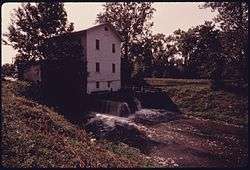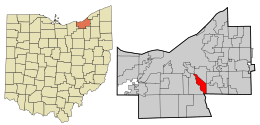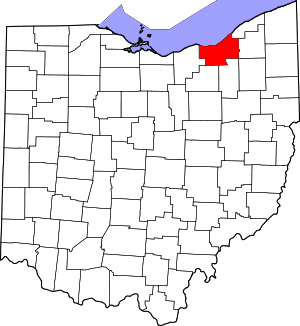Valley View, Ohio
Valley View is a village in Cuyahoga County, Ohio, United States. The population was 2,034 at the 2010 census.[6] It is a suburb of Cleveland with a town council form of government. It is part of a school district that also includes nearby Cuyahoga Heights and Brooklyn Heights. Its name refers to the Cuyahoga River valley,[7] and the town includes part of the Cuyahoga Valley National Park and the Ohio and Erie Canal. It is home to the Valley View Bridge that is on Interstate 480 and crosses the Cuyahoga River. The bridge is one of the major points that locals refer to as where the east side meets the west side of Cleveland.
Valley View, Ohio | |
|---|---|
 The old Alexander's Mill | |
 Location in Cuyahoga County and the state of Ohio. | |
.svg.png) Location of Ohio in the United States | |
| Coordinates: 41°23′7″N 81°37′4″W | |
| Country | United States |
| State | Ohio |
| County | Cuyahoga |
| Incorporated | 1919 |
| Government | |
| • Type | Mayor-council |
| • Mayor | Jerry Piasecki |
| Area | |
| • Total | 5.56 sq mi (14.41 km2) |
| • Land | 5.43 sq mi (14.07 km2) |
| • Water | 0.13 sq mi (0.34 km2) |
| Elevation | 863 ft (263 m) |
| Population | |
| • Total | 2,034 |
| • Estimate (2019)[3] | 1,997 |
| • Density | 367.57/sq mi (141.93/km2) |
| census | |
| Time zone | UTC-4 (EST) |
| • Summer (DST) | UTC-4 (EDT) |
| Zip code | 44125 |
| Area code(s) | 216 |
| FIPS code | [4] |
| GNIS feature ID | [5] |
| Website | www.valleyview.net |
History
Valley View was incorporated as a village in 1919 after it broke away from Independence, Ohio, after an argument over the location of the schools. Former Mayor Randall Westfall resigned from office on March 8, 2013. Council President Jerry Piasecki took over as Mayor. An election was held in November 2013 to determine who will serve as Mayor for the remainder of Westfall's term, which ends in 2015. Mr. Piasecki won the election. [8]
Geography
Valley View is located at 41°23′7″N 81°37′4″W (41.385153, -81.617670).[9]
According to the United States Census Bureau, the village has a total area of 5.57 square miles (14.43 km2), of which 5.44 square miles (14.09 km2) is land and 0.13 square miles (0.34 km2) is water.[10]
Demographics
| Historical population | |||
|---|---|---|---|
| Census | Pop. | %± | |
| 1920 | 403 | — | |
| 1930 | 594 | 47.4% | |
| 1940 | 753 | 26.8% | |
| 1950 | 998 | 32.5% | |
| 1960 | 1,221 | 22.3% | |
| 1970 | 1,422 | 16.5% | |
| 1980 | 1,576 | 10.8% | |
| 1990 | 2,137 | 35.6% | |
| 2000 | 2,179 | 2.0% | |
| 2010 | 2,034 | −6.7% | |
| Est. 2019 | 1,997 | [3] | −1.8% |
| U.S. Decennial Census[11] | |||
2010 census
As of the census[2] of 2010, there were 2,034 people, 758 households, and 583 families living in the village. The population density was 373.9 inhabitants per square mile (144.4/km2). There were 790 housing units at an average density of 145.2 per square mile (56.1/km2). The racial makeup of the village was 96.9% White, 0.2% African American, 0.9% Asian, 0.1% Pacific Islander, 0.4% from other races, and 1.4% from two or more races. Hispanic or Latino of any race were 1.3% of the population.
There were 758 households, of which 30.5% had children under the age of 18 living with them, 65.6% were married couples living together, 7.5% had a female householder with no husband present, 3.8% had a male householder with no wife present, and 23.1% were non-families. 19.5% of all households were made up of individuals, and 10.1% had someone living alone who was 65 years of age or older. The average household size was 2.68 and the average family size was 3.09.
The median age in the village was 47.3 years. 21.2% of residents were under the age of 18; 6.6% were between the ages of 18 and 24; 18.8% were from 25 to 44; 37.1% were from 45 to 64; and 16.3% were 65 years of age or older. The gender makeup of the village was 50.6% male and 49.4% female.
2000 census
As of the census[4] of 2000, there were 2,179 people, 779 households, and 634 families living in the village. The population density was 386.9 people per square mile (149.4/km2). There were 794 housing units at an average density of 141.0 per square mile (54.5/km2). The racial makeup of the village was 98.26% White, 0.32% African American, 0.05% Native American, 0.69% Asian, 0.37% from other races, and 0.32% from two or more races. Hispanic or Latino of any race were 0.50% of the population.
There were 779 households, out of which 34.0% had children under the age of 18 living with them, 70.9% were married couples living together, 7.8% had a female householder with no husband present, and 18.6% were non-families. 16.4% of all households were made up of individuals, and 6.8% had someone living alone who was 65 years of age or older. The average household size was 2.80 and the average family size was 3.16.
In the village, the population was spread out, with 24.0% under the age of 18, 7.6% from 18 to 24, 23.8% from 25 to 44, 30.7% from 45 to 64, and 14.0% who were 65 years of age or older. The median age was 42 years. For every 100 females, there were 99.4 males. For every 100 females age 18 and over, there were 95.2 males.
The median income for a household in the village was $64,063, and the median income for a family was $71,080. Males had a median income of $50,521 versus $32,589 for females. The per capita income for the village was $26,560. About 2.8% of families and 3.1% of the population were below the poverty line, including 4.3% of those under age 18 and 3.3% of those age 65 or over.
References
- "2019 U.S. Gazetteer Files". United States Census Bureau. Retrieved July 28, 2020.
- "U.S. Census website". United States Census Bureau. Retrieved 2013-01-06.
- "Population and Housing Unit Estimates". Retrieved May 21, 2020.
- "U.S. Census website". United States Census Bureau. Retrieved 2008-01-31.
- "US Board on Geographic Names". United States Geological Survey. 2007-10-25. Retrieved 2008-01-31.
- "Profile of General Population and Housing Characteristics: 2010 Demographic Profile Data (DP-1): Valley View village, Ohio". United States Census Bureau. Retrieved November 23, 2011.
- Overman, William Daniel (1958). Ohio Town Names. Akron, OH: Atlantic Press. p. 136.
- http://www.newsnet5.com
- "US Gazetteer files: 2010, 2000, and 1990". United States Census Bureau. 2011-02-12. Retrieved 2011-04-23.
- "US Gazetteer files 2010". United States Census Bureau. Archived from the original on 2012-01-25. Retrieved 2013-01-06.
- "Census of Population and Housing". Census.gov. Retrieved June 4, 2015.
External links
| Wikimedia Commons has media related to Valley View, Ohio. |
